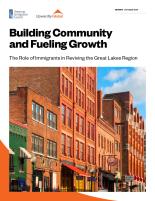- Special Report
Building Community and Fueling Growth: The Role of Immigrants in Reviving the Great Lakes Region
Published
The Great Lakes region has long been an emblem of America’s industrial strength, anchoring the nation’s steel, auto, rubber, and other factories and at one point employing more than half of the country’s industrial workforce. As labor-intensive factory work moved south and overseas, however, then diminished due to automation, the “Rust Belt” became a symbol of America’s waning industrial dominance.
After decades of decline, the Great Lakes region is now showing signs of a revival. Population numbers are ticking upward. Home values in once-forlorn neighborhoods are rising. The manufacturing industry has been adding a considerable number of new jobs—including 412,800 jobs between 2010 and 2022. The healthcare industry—one of the region’s fastest-growing industries—added nearly a half million workers during this period. By 2022, the industry had 14 job postings for every one unemployed worker.
Immigrants are playing a pivotal—and growing—role in this revival. While many industries struggle with labor shortages, immigrants have taken on the hard-to-fill jobs, reinvigorating the regional workforce and supporting the economic growth in America’s former industrial heartland. By bolstering fast-growing industries like advanced manufacturing and healthcare, they are helping create more opportunities for communities and families that have lived in the area for generations.
- Immigration fuels population growth in the Great Lakes region. The immigrant population of the region increased by 15.9 percent between 2010 to 2022, while the U.S.-born population increased by just 0.3 percent. As a result, immigrants were responsible for 78.5 percent of the region’s population growth during that time.
- Immigrants are keeping the workforce viable. Just 61.7 percent of U.S.-born residents in the region were of working age in 2022, a share that has continued to drop as the population ages. By contrast, 78.2 percent of the area’s foreign-born residents were of working age, making them vital to the region’s economic vitality.
- Immigrants are bringing talent to the region. The share of foreign-born residents in the Great Lakes region with at least a bachelor’s degree rose 6.2 percentage points between 2010 and 2022, to 39 percent. About 19.3 percent of foreign-born residents held an advanced degree.
- Immigrant workers are critical to the manufacturing industry. Immigrants continued to work in large numbers at hard-to-fill factory jobs, occupying 42.5 percent of meat processing jobs and 30.8 percent of hand-packer jobs. Immigrants also comprised 16.4 percent of the STEM workforce at a time when manufacturing industries—including aircraft and pharmaceutical manufacturing—are in need of high-skill workers like physical scientists, logisticians, and software developers.
- Immigrants serve critical and outsize roles in healthcare. In 2022, immigrants made up 27.8 percent of the region’s physicians, 20.6 percent of its surgeons, and nearly 17 percent of both its dentists and personal care aides, despite comprising just 7.8 percent of the population. As the Great Lakes region population ages, healthcare has become its fastest-growing field. And with a growing shortage of healthcare professionals, immigrants will continue to play a vital role in the well-being of people in the region.
- Immigrants contribute billions of dollars to governments and businesses in the region. Immigrant households generated $236.6 billion in income in 2022 and paid $65.7 billion in taxes, $23.9 billion of which went to state and local governments—money that helps fund schools, roads, and other public services. They held $170.9 billion in spending power—much of it circulated within the regional economy for groceries, transportation, housing, and other consumer goods.
Help us fight for immigration justice!
The research is clear – immigrants are more likely to win their cases with a lawyer by their side. But very few can get attorneys.
Introducing the Immigration Justice Campaign Access Fund.
Your support sends attorneys, provides interpreters, and delivers justice.

Immigration Justice Campaign is an initiative of American Immigration Council and American Immigration Lawyers Association. The mission is to increase free legal services for immigrants navigating our complicated immigration system and leverage the voices and experiences of those most directly impacted by our country’s immigration policies to inform legal and advocacy strategies. We bring together a broad network of volunteers who provide legal assistance and advocate for due process for immigrants with a humane approach that includes universal legal representation and other community-based support for individuals during their immigration cases.

